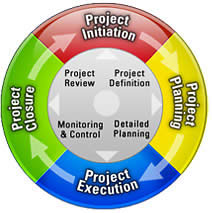Main menu
You are here
Project Management Life Cycle
Project Management Life Cycle


Initiate
In this first project management phase, the preliminary work is done to clarify the problem or opportunity and how a solution would look. All interested parties (the project stakeholders) are consulted and the project scope – what is in and what is out – is clarified as well as initial costings and timelines.
Plan
Here, more work is done to determine whether the proposed project will be of re
al benefit to the organization. If it is, the project is approved and more detailed planning starts. Business benefits, project objectives, requirements, governance, scope and project management methodology are agreed. The Project Manager draws up the detailed project schedule and task and budget allocations.
Execute
This is where the nuts and bolts work actually gets done. Project stakeholders are interviewed to ascertain the detailed requirements, possible solutions are discussed and one decided upon. Next, the solution is designed, built and finally implemented. Project management activities in this phase also include managing the project budget and schedule, reporting project progress, communicating with stakeholders and responding to project risks, issues and proposed changes.
Evaluate
The purpose of this final phase is to determine whether the project was a success and what learnings can be gleaned and applied to future projects. Evaluation is typically conducted in order to answer three questions. Firstly, did the project deliver on time, within budget and to scope and quality requirements? Secondly, were project stakeholders and project team members satisfied with the project? Thirdly, did the project achieve the envisaged business benefits?
source :www.businessperform.com

